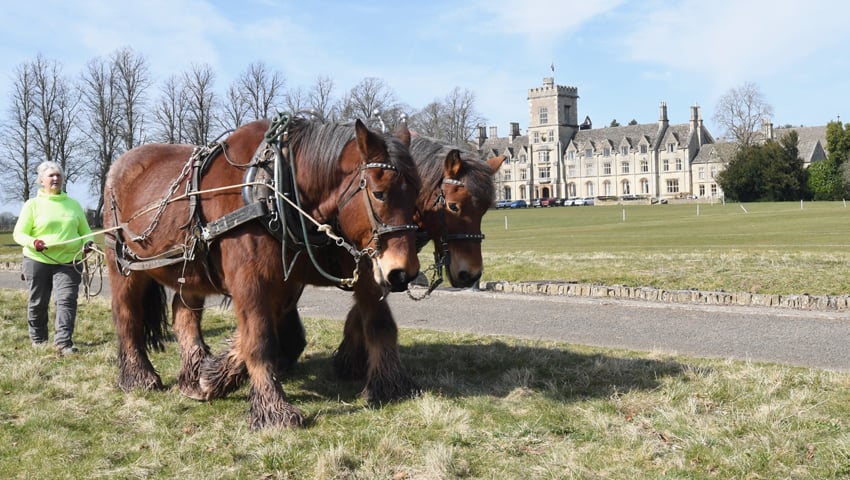Heavy horses have once again returned to the fields at the Royal Agricultural University (RAU) in sessions to show students the sustainability benefits of using horses rather than agricultural machinery.
In a scene reminiscent of those which would have taken place on the fields surrounding the campus throughout the University’s 180-year history, Ardennes heavy horses Sol and Kipp helped teach the University’s agriculture, agroecology, and equine students how horses can be used various agricultural and countryside management tasks, including logging.
Organised jointly between the RAU and the Farming and Wildlife Advisory Group (FWAG) South West, which runs the GREAT Zerodig site on land next to the University’s historic Cirencester campus, the horses were working on land at the Zerodig site with their owner Kate Mobbs-Morgan.
Dr Andrew Hemmings, RAU Associate Professor in Equine Research Leadership, said, “Today we have been able to show our students first-hand how horses can be used in small and larger scale farming operations and how working in this way can have enormous sustainability benefits.
“There is increasing industry demand for low impact logging strategies and the advantages of horse logging, compared to the use of machines, in sensitive woodland areas are huge. There is also the potential for horses to ‘regenerate as they work’ with selective grazing that promotes the growth of valuable plant species.
“We firmly believe that horses have a key role to play in modern farming systems. By embracing horse power on farms, not only do we reduce our reliance on fossil fuels, but we also create enduring bonds between horses and humans whilst preserving these wonderful breeds for future generations.
“With mental health issues becoming more common in isolated farming communities, the physical and psychological health benefits of horse contact are manifold!”
Traditionally, heavy horses would have been used for many jobs on the farm, including timber extraction, mowing, harrowing, and bracken bashing.
Using conventional agricultural machinery to do these tasks in often fragile habitats, with soils that have developed solely from natural processes, can damage the important underground networks of fungi and root systems that benefit associated ground flora.
Edward Bonn, who works with FWAG South West to run the GREAT Zerodig site, said, “Woodland soils and their ecosystems are fragile, irreplaceable habitats that host a vast array of fascinating, often rare, plants.
“With their biodiversity value, these ecosystems can be compared to a classic painting in terms of their structural complexity, range of colours and textures, and sheer beauty.
“This traditional method, combined with advances in technology and equipment, provides a new opportunity to bring structural complexity and biodiversity back to our precious woodlands.”
As well as learning about the importance of using horses in sustainable agriculture and land management, the students also had the opportunity to get “hands on” themselves with handling the horses, fitting the harnesses, and even ‘driving’ the horses during the various tasks.
Dr Jonathan Code, RAU Senior Lecturer in Sustainable Land Management, said, “By 2050 the world’s population is due to rise to nearly 10 billion which raises the question – how we will we feed everyone?
“One approach is to embrace larger farms covering more land with bigger machines. However, in the context of dwindling oil reserves and rising prices, this tactic may become a less viable option.
“We believe that multiple small scale farming operations could be the way forward and, instead of looking towards alternative ways of fuelling machines, let’s reconnect with the power of horses in these farming operations.
“As creatures, horses and humans have enjoyed a mutually beneficial relationship that has developed over the last 6,000 years, but which has lapsed significantly over the past century.
“If the farm is cared for as a dynamic organism in its own right, rather than merely a factory for producing calories, perhaps it is time to rekindle the relationship with the return of horses to our agricultural landscapes.”
Kate Mobbs-Morgan uses Sol and Kipp to run her forestry enterprise – offering services from felling to extraction and cutting timber – in South Wales.
She added, “Horses very much come into their own with their ability to work on sites which are difficult to access with machinery, such as those which are steep or wet, and sites which are archaeologically or ecologically sensitive where machinery would be inappropriate.
“The log extraction methods we use with the horses naturally scarify the soils as they work and we often see the added benefits afterwards with increased flora and woodland regeneration from seed banks sitting just below the surface. I feel very much that horses are a viable option in current woodland and land management.”
Dr Hemmings concluded, “Ardennes horses are an ancient breed with physical and temperament characteristics that make them ideal for these tasks. Julius Caesar favoured the Ardennes for its durability and bravery, so did Napoleon in his Russia Campaigns, and it has been fantastic, for both us and our students, to be able to see them working today.
“With the rise of intensive agriculture, many of our heavy horse breeds have become seriously endangered, and finding roles for them on the farm would reverse this worrying trend.
“While the Ardennes breed itself is not currently endangered, many heavy horse breeds, such as the Suffolk Punch, are on the critically endangered list. By preserving agricultural practices from the past, we are working towards a sustainable future.”
Image credit: Paul Nicholls
